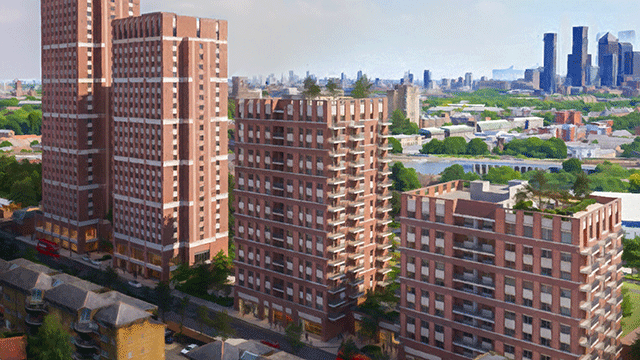Land – Development – Access to Neighbouring Land Act 1992 – Claimant seeking access to defendant’s land to re-render and repaint wall – Defendant refusing permission – Claimant applying to court under 1992 Act for order allowing access – Whether works reasonably necessary for preservation of claimant’s property – Application granted
The claimant owned a property called Amberwood House which was in South Kensington at the end of a private road opposite the Victoria & Albert Museum. It was being redeveloped by the claimant, which involved removing all the interior walls and fittings, leaving only the external walls, digging out two or three levels of basement and refitting it to a very expensive standard.
The defendant was the owner of the adjacent property called Thurloe Lodge. It was the subject of a similarly scaled project, involving the substantial rebuilding and enlargement of the original building. The so-called “shell and core” works had been completed and the contractors were turning their attention to the internal fit out.
The claimant sought access to the defendant’s land in order to re-render and repaint the north wall of Amberwood House which was right on the boundary of the land on which it sat. Its exterior could only be worked on from a narrow passageway between the two buildings which was on the defendant’s land. The parties were unable to agree terms on which the claimant might gain access to carry out the works which it said were reasonably necessary for the preservation of its property, Therefore, the claimant applied for an order granting access under the Access to Neighbouring Land Act 1992.
Held: The application was granted.
(1) Section 1 of the 1992 Act required the court to determine whether to grant access by considering five questions in a particular order: (i) whether the works were reasonably necessary for the preservation of the whole or any part of the claimant’s land; (ii) whether it would be impossible, or substantially more difficult, to carry out the works without entry to the other land; (iii) if the order was granted, whether the defendant or any other person suffer would interference with, or disturbance of, his use or enjoyment of the servient land; (iv) if the order was granted, whether the defendant any other person occupying the land would suffer hardship; and (v) whether the interference, disturbance or hardship occasioned by reason of the entry onto the land would occur to such a degree that it would be unreasonable for the court to make the order.
If the answer to questions (i) and (ii) was no, the court had no jurisdiction to make an order for access under the 1992 Act. If the answer to both questions (iii) and (iv) was no, the court should grant an order, although the judge retained a discretion as to the terms of the order.
(2) The proposed works had to be “maintenance, repair or renewal” within section 1(4)(a) of the 1992 Act and the application for access and the works “reasonably necessary”. Those words conveyed a broad impression of the types of work to be considered as potentially justifying an access order. The works proposed by the claimant might fall into any of those categories. They amounted to “maintenance, repair or renewal” and fell within the definition of “basic preservation works”.
The defendant’s argument that the works were required merely for aesthetic reasons which were “reasonably necessary for the preservation” of the wall ignored the deeming provision in section 1(4) which had the effect that if works were within the category of “basic preservation works” (which included works of maintenance, including works of repair or of renewal) and were shown to be reasonably necessary, then the test of “reasonably necessary for the preservation of the property” was met.
The reasons for introducing the Act were focused on works necessary to stop a property rotting away but there might be circumstances where aesthetic issues might have some bearing on the matter because of the character of the property and the locale in which it sat.
The claimant had demonstrated that there were good reasons why the rendering needed to be reapplied for reasons that were clearly relevant to the preservation of the wall. The term “reasonably necessary” required the judge to take a broad view. In many cases, there might be some latitude in how urgently the works were required to be done. The fact that it might be reasonable to order the works to be done later did not affect the court’s jurisdiction to make the order, although it might affect its terms.
(2) The defendant acknowledged that if the works needed to be done, they could not be done without access to the defendant’s land.
(3) If the order was granted, it would cause interference with, or disturbance of, the use or enjoyment of the defendant’s land which covered the effect on any occupier of the land, which would include the defendant’s contractor.
(4) If the order was granted neither the defendant nor any other person occupying the land would suffer “hardship” which was a strong word, connoting more than mere inconvenience. It could encompass financial hardship but the court should determine whether hardship was imposed, especially in relation to financial hardship, by reference to the order itself, rather than looking just at the proposal for access and the works to be undertaken.
Under section 2(3) of the Act the court had wide powers to specify how and when the works were to be carried out; the precautions that the claimant should take; and to require the claimant to pay for any loss, damage or injury, or any substantial loss of privacy or other substantial inconvenience. Furthermore, in some circumstances, the court might order the payment of a sum that the court considered to be fair and reasonable for the privilege of entering the defendant’s land. However, the prospect of financial loss had to be considered in framing the terms of any order that the court might grant.
(5) The Act provided the court with wide powers to make any order subject to conditions that would lessen the impact of the access and the works on the defendant. The court should not ignore its ability to use those powers when determining whether it should make an order. Accordingly, where it heard a legitimate objection to the proposal from the defendant, the court should consider how those objections could be mitigated through the terms of the order.
John de Waal QC (instructed by Dentons UK and Middle East LLP) appeared for the claimant; Mark Warwick QC (instructed by Kennedys Law LLP) appeared for the defendant.
Eileen O’Grady, barrister
Click here to read a transcript of Prime London Holdings 11 Ltd v Thurloe Lodge Ltd








